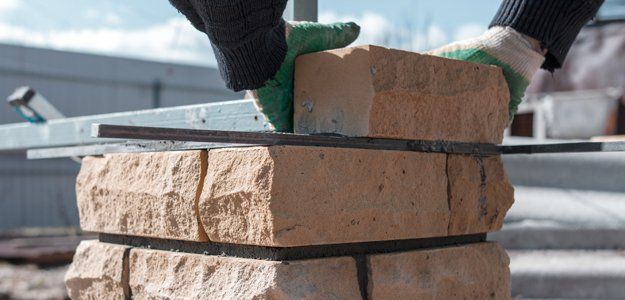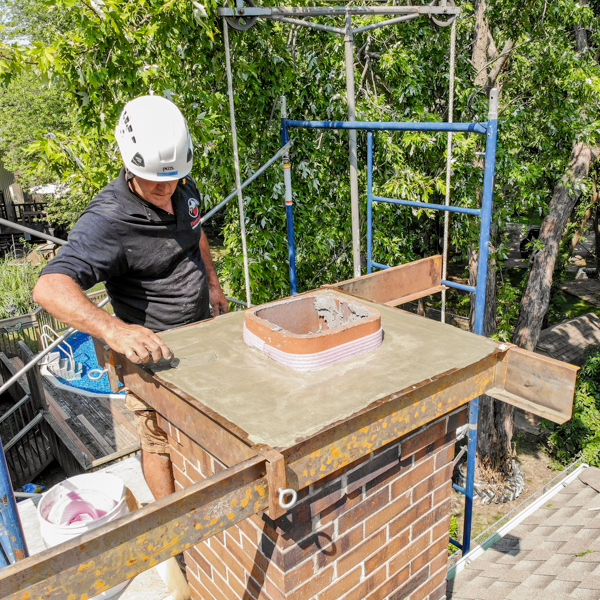The 6-Minute Rule for Tuckpointing
Table of ContentsPatio Installation Things To Know Before You Get ThisThe Buzz on Chimney Flashing And Cap RepairGet This Report about Patio InstallationExcitement About Paver InstallationThe Main Principles Of Chimney Flashing And Cap Repair What Does Chimney Flashing And Cap Repair Do?

The acid dissolves all the carbonate-containing minerals not only in the binder, but likewise in the accumulation (such as oyster coverings, coral reefs sands, or other carbonate-based materials), as well as any type of other acid-soluble materials. The sand and also fine-grained acid-insoluble material is left behind. There are several variations on the easy acid digestion test.
Simple acid digestion methods are fast, economical, and also easy to carry out, but the information they provide regarding the original composition of a mortar is restricted to the shade and also structure of the sand. The gas collection technique offers more information regarding the binder than a basic acid digestion test. analysis methods that have actually been utilized to examine mortars include polarized light or thin-section microscopy, scanning electron microscopy, atomic absorption spectroscopy, X-ray diffraction, and differential thermal evaluation.
Getting The Roofing Contractor To Work
Historical mortars were not prepared to directly specified requirements from materials of consistent top quality; they contain a broad variety of in your area acquired products incorporated at the discernment of the mason. While a certain approach could be able to accurately identify the original percentages of a lime-cement-sand mortar prepared from modern-day products, the efficiency of that approach for evaluating historic mortars is suspicious unless it has actually been checked versus mortars prepared from materials much more typically utilized in the past.
It is a common error to think that firmness or high stamina is a step of appropriateness, specifically for lime-based historic mortars. Tensions within a wall triggered by growth, contraction, moisture migration, or negotiation needs to be fit in some manner; in a stonework wall surface, these tensions must be relieved by the mortar instead than by the stonework units.
High lime mortars are a lot more absorptive than denser cement mortars. Historically, mortar worked as a bed linen materialnot unlike an expansion jointrather than a "glue" for the masonry systems, and also dampness was able to move through the mortar joints rather than the stonework units. When dampness evaporates from the stonework it deposits any kind of soluble salts either externally as efflorescence or below the surface area as subflorescence.
Fascination About Paver Installation
If the mortar does not permitmoisture or moisture vapor to move out of the wall surface and also vaporize, theresult will certainly be damages to the stonework devices. Sand is the biggest element of mortar as well as the material that provides mortar its distinctive shade, appearance as well as cohesiveness. Sand should be without pollutants, such as salts or clay.


Top Guidelines Of Chimney Sweep
For repointing, rose city cement must comply with ASTM C 150. White, non- staining rose city cement may provide a far better color suit for some historical mortars than the much more commonly readily available grey portland concrete. It needs to not be presumed, nonetheless, that white rose city concrete is always ideal for all historic structures, considering that the initial mortar may have been blended with grey concrete.
Hydrated lime mortars, and pre-blended lime putty mortars with or without a matched sand are commercially offered. In the majority of instances, pre-blended lime mortars including sand might not give a precise match; nevertheless, if the job calls for overall repointing, a pre-blended lime mortar may be worth thinking about as long as the mortar is suitable in toughness with the stonework.
In either case, if a preblended lime mortar is to be made use of, it needs to contain Type S or SA hydrated lime satisfying ASTM C 207. Water needs to be potableclean and also without acids, antacid, or various other liquified natural products. In addition to the shade of the sand, the appearance of the mortar is of crucial relevance in duplicating historical mortar.
The 7-Second Trick For Patio Installation
The use of antifreeze compounds is not suggested. They are not extremely reliable with high lime mortars and may introduce salts, which may trigger efflorescence later on.
For repointing, lime needs to satisfy ASTM C 207, Type S, or Type SA, Hydrated Lime for Masonry Purposes. This machine-slaked lime is created to ensure high plasticity and also water retention. Using quicklime which should be slaked as well as saturated by hand may have advantages over hydrated lime in some remediation jobs if time as well as money allow.
For find out here now repointing, rose city concrete need to satisfy ASTM C 150. White, non- staining portland concrete might give a far better color match for some historic mortars than the more commonly readily available grey rose city concrete. It ought to not be assumed, nonetheless, that white portland concrete is constantly suitable for all historic buildings, since the initial mortar may have been mixed with grey concrete.
Chimney Services Fundamentals Explained
Therefore, they typically are not suggested for usage on historical stonework structures. Moisturized lime mortars, and pre-blended lime putty mortars with or you could try this out without a matched sand are commercially available. Personalized mortars are likewise offered with color. In many instances, pre-blended lime mortars including sand may not offer an exact match; nonetheless, if the project calls for total repointing, a pre-blended lime mortar might deserve considering as long as the mortar works in strength with the stonework.
In either case, if a preblended lime mortar is to be made use of, it ought to have Type S or SA moisturized lime complying with ASTM C 207. Water should be potableclean as well as devoid of find acids, alkalis, or various other dissolved natural products. In enhancement to the color of the sand, the structure of the mortar is of essential significance in replicating historic mortar.
Choice of admixtures need to be made by the architect or architectural conservator as component of the requirements, not something regularly included by the masons. Generally, modern chemical additives are unneeded and may, in truth, have damaging results in historical masonry projects. The use of antifreeze substances is not recommended. They are not really efficient with high lime mortars and also may introduce salts, which may trigger efflorescence later on.